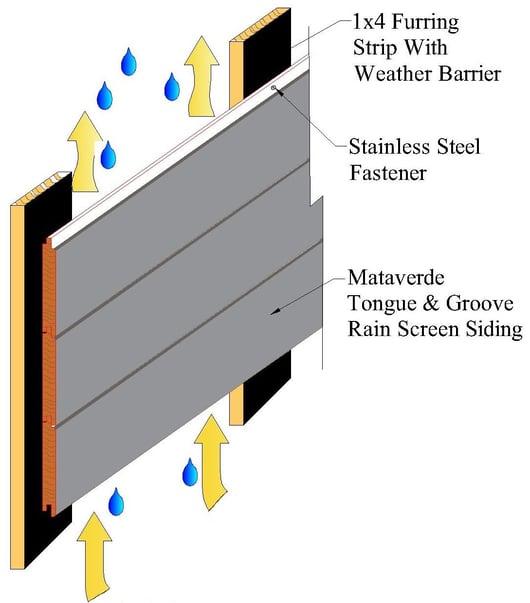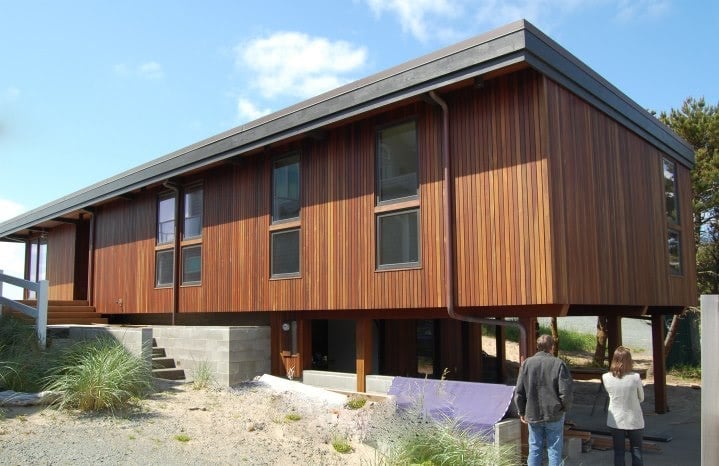
Why Use a Rainscreen System?
When cladding is attached directly to an exterior wall, with no space between the exterior siding and the building envelope, bad things can, and often do, happen. Namely, the potential for mold and rot. With nowhere for trapped moisture to go a catastrophic wall assembly failure can happen, slowly and hideously, over time.
Planning and building a well-designed rainscreen system can help eliminate any trapped moisture. This creates a healthier environment by minimizing the potential for mold and rot. It can also add decades of life to the exterior wall and the structure. The life cycle of the property is extended, and a healthier living space is created.
Well-designed rainscreens protect your home or building from the weather outside. They also allow your home to ‘breathe better’, ventilate better, reduce the potential for mold, and provide a passive insulation barrier to boot. There are many types of wood rainscreens, that is, a rainscreen system that uses wood siding.
What Can Happen Without a Rainscreen?
Without a method to let moisture escape, the moisture often gets trapped between the back of the siding and the weather resistive barrier (WRB). From there, mold spores blossom and the wood siding begins to rot. Then, since any moisture behind the WRB now has nowhere else to go, the sheathing will eventually rot, too.

Moisture needs a way to vent. Without it bad things can happen.
Mold is now well over a billion-dollar per year industry. Mold in an exterior wall assembly creates health issues and building envelope failures.
That’s why architects, designers and knowledgeable builders are turning to rainscreen siding installations and methods. A rainscreen system is designed to create a gap between the siding and the exterior sheathing. A well designed rainscreen system will allow moisture to ventilate out of the wall cavity.
What is a Rainscreen Cladding System?
One thing that all rainscreen cladding systems have in common is that they all offer a double layer of protection for your home or building. The three elements of a rainscreen system include a weather resistive barrier, a cladding material, and an air gap between these two layers.
• The weather resistive barrier (WRB) is the first layer of protection. In wood frame construction a WRB is used to cover the exterior plywood or sheathing over the insulated area of your structure (the building envelope). They usually work in two directions. They protect rain, snow, sleet and water from getting inside. They also allow moisture from inside to pass through to the outside. It is critical to make sure that you choose a high quality WRB and that it is installed properly.
• The exterior cladding can be anything from metal siding to composites to fiber cement to wood siding to high quality HPL cladding and more. A “wood rainscreen” is one that uses wood siding or cladding.
• A rainscreen gap is the space that you leave between the WRB and the exterior cladding. This is where all the magic happens. With a well designed rainscreen, any bulk water from the outside that happens to sneak in past the siding, will drain out through the rainscreen gap. Any moisture that ventilates from the inside should vent out through the rainscreen gap, too.
Different Types of Wood Rainscreen Systems
All wood rainscreens look pretty much the same from the outside. But it is the area behind the siding, the part that you can't see after it's installed, that provides all benefits. How can you tell the difference? How can you tell which wood rainscreen system is right for you? Here's a look at the most common rainscreen siding systems for wood siding.
Simple Rainscreen with a “Rainscreen” Weather Resistive Barrier
There are several weather resistive barriers that have a built in ‘rainscreen’. They have a spacer or mesh built-in to the weather resistive barrier. It is the simplest form of rainscreen for wood siding. It is quick and easy to install, and it keeps the siding spaced away from the building envelope. It creates a very small rainscreen gap. Some manufacturers make their WRB’s with different sized spacers depending on the climate in the area you are building. In general, the more rainfall, the larger the rainscreen gap.
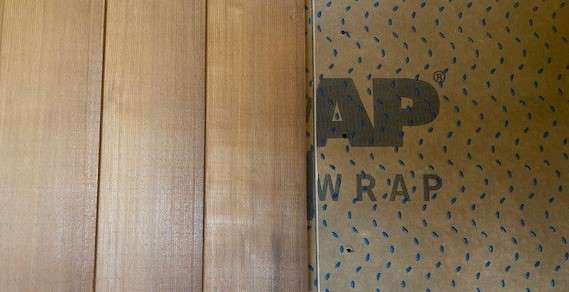
Example of T&G wood siding being installed over a "rainscreen" weather resistive barrier
This type of rainscreen system works well with clapboard siding and T&G wood sidings because the boards fit tightly together to create a ‘closed joint’ rainscreen. A closed joint rainscreen prevents most (not all) of the rain and elements away from the building envelope. In a well-designed and installed closed joint wood rainscreen the moisture behind the siding typically comes from inside the building. It is important to allow for ventilation at the top and bottom to allow moisture to escape.
Pros of a Wood Siding over "Rainscreen" WRB
- Installs quickly
- The weather resistive barrier and "rainscreen" are one step
- Eliminates the need and expense of furring strips
- Most experienced contractors are familiar with proper weather resistive barrier installation.
Cons of a Wood Siding over "Rainscreen" WRB
- The narrow rainscreen gap allows minimal back ventilation
- May not be the best option in all climates.
Basic Rainscreen System with Furring Strips
A popular method of creating a rainscreen system is to use furring strips on the exterior wall and fasten your siding boards to the furring strips. With typical thickness wood furring this will create a ¾” rainscreen gap. This wider rainscreen gap leaves plenty of space for bulk water and moisture to ventilate. Building scientists agree that a rainscreen gap of ¾” behind wood siding is highly effective. That’s why a ¾” thick wood furring strip makes so much sense.
Using a furring strip is the most basic way to create a wood rainscreen. Most skilled carpenters and siding professionals have experience using a wood furring strip to space the siding off the exterior wall of a façade. This space the furring strips create behind the siding is known as the ‘rainscreen gap’ or ‘wall cavity’.
Pros of a Wood Rainscreen with furring strips:
- Furring strips are readily available.
- Hardwood furring strips work best.
- Most experienced contractors are familiar with proper furring strip installation techniques.
- ¾” thick furring strips automatically create a ¾” rainscreen gap.
- This type of rainscreen installation is 80% effective by design, making this method far more effective than not using a rainscreen.
- Using a weather resistant tape over the furring strips makes them less likely to rot.
Cons of a Wood furring strip rainscreen:
- The labor time of installing furring strips takes longer than using a rainscreen clip.
- The material cost and labor cost of furring strips, typically adds about $2 or so per square foot to the project cost.
- Furring strip rainscreens are about 80% effective by design, but rainscreen clip installations without furring strips are roughly 96% efficient.
- If not installed properly and protected, wood furring strips can rot.
- Must ensure air flow at top and bottom of each cavity- this is a closed joint rainscreen.
See Typical T&G Wood Siding Profiles for Closed Joint Rainscreens
The Climate-Shield Rainscreen System
A wood rainscreen assembly using furring strips is better than no rainscreen at all. However, there are much better ways to create a higher performance wood rainscreen. The Climate-Shield Rainscreen System was developed to meet these needs. The main difference between the Climate-Shield Rain System and furring strip rainscreen assemblies are:
- No furring strips are needed. This saves installation time and reduces your labor and material costs.
- Open Joint rainscreen. The wood siding is designed to leave a small space between the siding boards. This creates an ‘open joint’ rainscreen. An open joint rainscreen provides superior ventilation and a healthier wall assembly.
- Pressure equalized. A ‘pressure equalized’ rainscreen is also created. This means that your wall cavity will dry out, quickly, effectively, and effortlessly. A pressure equalized rainscreen also provides superior performance in high wind zones.
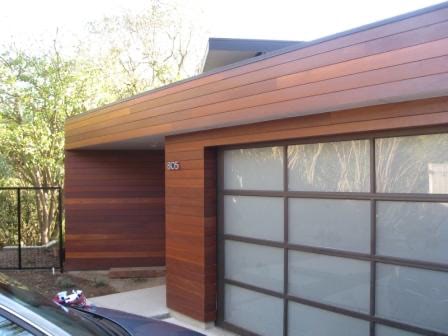
Climate-Shield wood rainscreen siding project
Climate-Shield CS2 Rainscreen System and Components
The Climate-Shield CS2 rainscreen system is the most robust and highest performing group of components. The basic system uses the CS2 rainscreen clip and a starter rail, to create various types of rainscreens. With the CS2 assembly, you can design and build a vertical, horizontal, or diagonal wood rainscreen.
The CS2 rainscreen system can be used for commercial or residential designs over a variety of different wall assemblies, including plywood, masonry, rigid insulation, exterior drywall and more. Additional Climate-Shield components are available with the CS2 rainscreen system including a horizontal starter rail, vertical starter rail, attachment channel, z-girts, and wood and aluminum outside corner options.
Here's how the Climate-Shield Rainscreen system works:
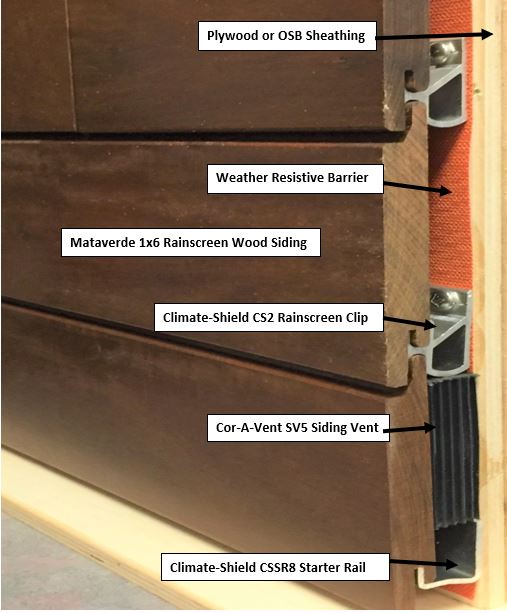
Every component you need to create and build a high performance rainscreen is included in the system.
Pros of a Wood Rainscreen with CS2 Rainscreen Clips:
- The CS2 rainscreen clip automatically creates a consistent ¾” rainscreen gap, without using furring strips.
- CS2 uses two screws per rainscreen clip for higher holding power.
- The Climate-Shield rainscreen system with CS2 components is engineered to exceed the wind load requirements in hurricane and high wind zones.
- Rated for over 220 MPH winds and seismic equivalent.
- Installs vertically, horizontally, or diagonally.
- Can be used on commercial and residential designs.
- Installs quickly.
- Minimizes wood siding waste.
- Additional Climate-Shield accessories are available for various designs, including z-girts, attachment channels and outside corner options.
Cons of a Wood Rainscreen with CS2 Rainscreen Clips:
- Because of the ¾” rainscreen gap behind the siding, window and door trim may be required around fenestration.
- Although the system installs stronger and faster than furring strip installations, 2 screws per clip takes slightly longer than 1 screw per clip.
- Because it is an open joint rainscreen, it is imperative that the weather resistive barrier is installed properly.
Climate-Shield CS10 Rainscreen Clips and Components
The Climate-Shield CS10 rainscreen system is designed with a lower clearance 10mm rainscreen gap (approx. 3/8”). It is designed for faster installation of horizontal siding and soffit installations.
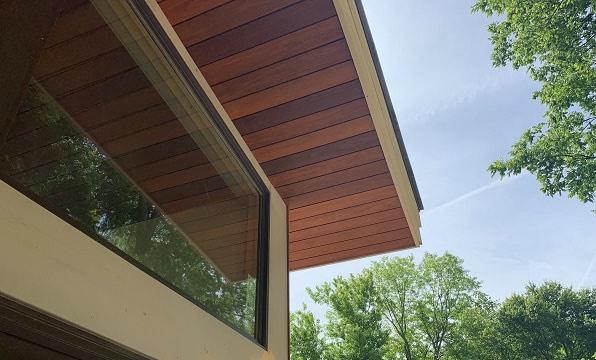
Ipe wood rainscreen siding and soffits using the Climate-Shield CS10 specialty clip
Pros of a Wood Rainscreen with CS10 Rainscreen Clips:
- Creates an open joint, pressure equalized rainscreen.
- Installs easily with 1 screw per rainscreen clip.
- Works great for residential horizontal siding installations
- The lower clearance works great around most window and doors, without the need for additional trim around these openings.
- Excellent option for residential remodeling and re-cladding projects.
- Ideal for soffits
- Designed to meet wind load requirements of more than 160 MPH.
Cons of a Wood Rainscreen with CS10 Rainscreen Clips:
- Although the CS10 is not quite as robust as the CS2 rainscreen components, it still outperforms wood furring strip installations and other rainscreen clips on the market.
- The 3/8” rainscreen gap dries out quickly, but not quite as fast as the CS2 rainscreen clip.
- Because it is an open joint rainscreen, it is imperative that the weather resistive barrier is installed properly.
Conclusion
Are you still trying to decide which wood rainscreen system will work best for you? Here’s a comparison chart to outline the differences between the wood furring strip option and the two Climate-Shield rainscreen options listed above.
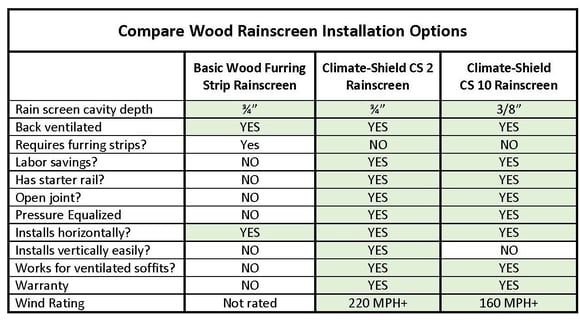
Looking for more information about rainscreen systems?
Download “The Ultimate Guide to Wood rainscreens” today.
Would you look to see some amazing wood rainscreen projects?
Visit Wood Rainscreen Siding Project Galleries here
OR
Download the Featured Rainscreen Projects Portfolio here:
Related Posts






